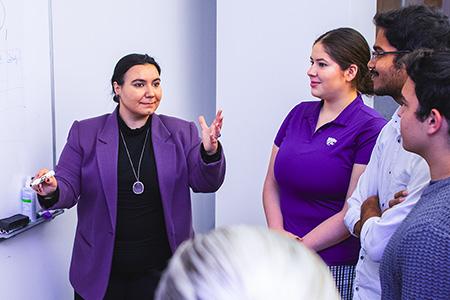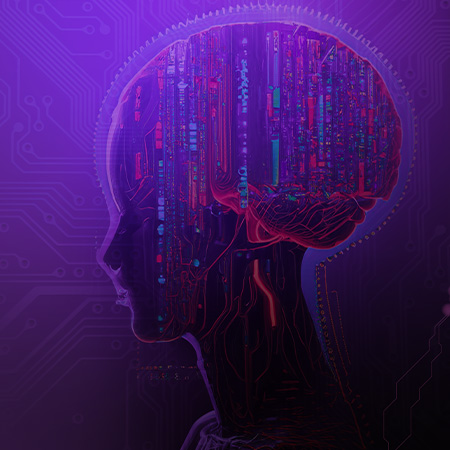Making artificial intelligence smarter, safer
Improving the intelligence behind AI
By Ben Trickey
Just like a magician pulling a rabbit out of a hat, today’s generative artificial technologies such as Midjourney and ChatGPT can seem magical by making a convincing image or wall of text appear in just seconds.
Helping to make this AI magic happen are faculty and student researchers at Kansas State University. They work to better understand the intricacies of generative AI systems and define both their applications and limitations so they are safe, efficient and accessible.
It’s not only computer scientists and engineers who contribute to this research. Interdisciplinary collaboration at K-State has become integral to understanding how these models can help answer questions and solve complex problems in agriculture, applied psychology, data management, human health and more.
To coordinate their collective expertise across the university and beyond, these researchers have already begun working toward a better understanding of generative artificial intelligence technologies and their growing potential.
AI and sustainable agriculture
AI is often marketed as a tool for automating mundane tasks — virtual assistants to maintain your calendar, generative AI to draft your emails and self-driving cars to simplify your daily commute. These examples only scratch the surface of AI’s time-saving capabilities.
Researchers in K-State’s Center for Artificial Intelligence and Data Science, or CAIDS, in the Carl R. Ice College of Engineering study theoretical and applied data science, AI and the connections between them. Because AI is only as good as the data it relies on, research at the center includes developing more efficient strategies for data collection and analysis.
 Pascal Hitzler, the director of CAIDS, Lloyd T. Smith creativity in engineering chair and professor of computer science, leads this research in the Data Semantics Lab, a part of the center. Hitzler and his students study and develop tools for data analytics, such as knowledge graphs.
Pascal Hitzler, the director of CAIDS, Lloyd T. Smith creativity in engineering chair and professor of computer science, leads this research in the Data Semantics Lab, a part of the center. Hitzler and his students study and develop tools for data analytics, such as knowledge graphs.
Knowledge graphs are representations of data that use nodes and arrows to represent the relationships between concepts as formal logics. These graphs help contextualize and integrate data, especially for use in machine learning.
“Data scientists typically say about 80% of their work has to do with data management, and only the last 20% is the actual analysis, which then gives you the interesting outcome,” Hitzler said. “Essentially, knowledge graphs are an intelligent way of organizing data — intelligent in the way that reusing the data for new purposes is much cheaper and easier.”
These systems are already being applied to projects at K-State’s Center for Sustainable Wheat Production in the College of Agriculture, an interdisciplinary initiative focused on integrating large datasets to inform more efficient and sustainable decision-making in wheat production.
Funded by one of three 2023 K-State Game-changing Research Initiation Program, or GRIP, awards, this project acts as the first step in creating a global food systems data hub. The data hub itself would use knowledge graphs to integrate and analyze big data and address the complexities of the global food system.
Hande Küçük McGinty, assistant professor of computer science and CAIDS faculty member, explains the additional role knowledge graphs play in interdisciplinary research.
member, explains the additional role knowledge graphs play in interdisciplinary research.
“Sometimes different fields may hold nuances and different understandings of the same data,” McGinty said. “So how do you make sure that everybody’s speaking the same language? Knowledge graphs align our understanding of the same concepts.”
The Center for Sustainable Wheat Production alone includes researchers in computer science, engineering, agronomy, geography and geospatial sciences, agricultural economics and plant pathology. Establishing working relationships among disciplines inspires further collaboration as researchers share data and explore real-world problems.
“Several different sciences are coming together with these projects, which is so exciting to see,” McGinty said. “And it’s also exposing us to all kinds of different new realms and new challenges.”
The spirit of collaboration among data science, AI research and agriculture expands beyond wheat production. Hitzler and McGinty also contribute to the interdisciplinary Institute for Digital Agriculture and Advanced Analytics, or ID3A.
As ID3A’s director, Hitzler focuses the interdisciplinary collective’s efforts on using digital technology and analytics to support the goal of more sustainable agricultural practices.
“Agriculture has such tremendous opportunities for artificial intelligence to improve yield, decrease cost, projections, management decisions, etc.,” Hitzler said. “And this for me is a really exciting area, in particular for K-State, because we can bring our AI and agriculture people together to move it forward.”
Digging into deep learning
If knowledge graphs are the unsung heroes of AI research, deep learning is the star of the show. Using artificial neural networks — AI systems modeled on the structure of the human brain — deep learning takes the project of automating human cognition to a new level.
Deep-learning models are trained to organize and interpret data to autonomously provide suggestions or make decisions with increasingly little human interaction. By design, these systems exhibit incredible versatility in applications from diagnosing cancer via medical imaging to identifying species of bees to developing workplace personality profiles.
 In the study “How well can an AI chatbot infer personality?: Examining psychometric properties of machine-inferred personality scores,” Tianjun Sun, assistant professor of psychological sciences in the K-State College of Arts and Sciences, and her collaborators explore how conversational agents, or chatbots, can help workplaces create better personality assessments for hiring, career counseling and guidance.
In the study “How well can an AI chatbot infer personality?: Examining psychometric properties of machine-inferred personality scores,” Tianjun Sun, assistant professor of psychological sciences in the K-State College of Arts and Sciences, and her collaborators explore how conversational agents, or chatbots, can help workplaces create better personality assessments for hiring, career counseling and guidance.
Rather than relying on a questionnaire or a traditional interview, the chatbot prompts potential employees to share stories about their lives and creates personality profiles based on their responses.
“It’s pretty limited to evaluate personality based only on self-reports,” Sun said. “So, we’re looking at training systems or evaluating systems to recognize this more holistic picture of a person’s personality.”
Even as AI automates time-consuming processes, Sun’s research suggests that the human element in guiding these programs and validating their outputs is essential to their efficacy.
“The human involvement in my line of research essentially is to validate the utility of the tools,” Sun said. “Human samples really test how well the tools are working in terms of fairness, bias and other considerations.”
As part of his work in CAIDS, Hitzler employs human oversight to better understand the function of these systems’ internal decision-making processes.
“The hope of this is, of course, that we will get an understanding of what’s happening inside, but also give us a possibility of actually saying why,” Hitzler said. “It will tell us what the system was identifying — what was important for its decision and so on because we’d understand the internal structure.”
In the past, the success of deep-learning programs was based on the statistical success of the models’ outputs. However, in circumstances where the system is not working as designed, determining why the model has created an unsuccessful output requires significant time and effort. In many such cases, the user needs a fairly high level of expertise to identify an output as unsuccessful.
of the models’ outputs. However, in circumstances where the system is not working as designed, determining why the model has created an unsuccessful output requires significant time and effort. In many such cases, the user needs a fairly high level of expertise to identify an output as unsuccessful.
“Look at ChatGPT and the like. You can immediately see what the problem is if you try the systems out,” Hitzler said. “They’re extremely eloquent, but it may be completely confabulated. And the only way to know is if you’re actually an expert in what it’s talking about.”
Inaccuracies may seem trivial with a chatbot, but identifying confabulations becomes crucial when deep learning has life-altering applications. Hitzler suggested safety-critical applications, like self-driving cars, or ethical questions, like what factors cause a mortgage application to be rejected by an automated system.
“Essentially, building trust in these systems is also a technical challenge that needs to be looked at,” Hitzler said. “And I think this will still be important 10 years from now.”
Ongoing education, conversation
Although the influence of data management and deep learning has garnered significant research at K-State, the conversations around AI and its application expand far beyond these topics alone.
In October 2023, K-State held the interdisciplinary symposium AI and the Future: Exploring the Intersection of Language(s), Science and Ethics, organized by faculty across the university, including Raelynne Hale, modern languages; Alice Anderson, Jason Coleman and Carol Sevin, all from K-State libraries; and Hitzler.
A diverse group of faculty, students and community members attended three days of presentations, panels and workshops about AI technology, its role in education and the ethical questions surrounding the applications of AI in daily life.
As more AI technology becomes available to the public at breakneck speed, these conversations about technological education and literacy have become a necessity.
In her role as a computer scientist working with interdisciplinary teams, McGinty has hope for continued growth in educating the public about the core ideas necessary to understanding computer and data science.
“Kansas is one of the pioneer states in this. We’re already teaching and educating teachers in the computer science principles,” McGinty said. “I think it is a wonderful step in the right direction, starting early and getting education starting from that perspective.”
And although she believes in the growing potential of AI, McGinty weighs the promise of the technology alongside the importance of understanding its limitations.
“It’s really important for people to understand this, that these systems are decision support, not necessarily decision-making,” McGinty said. “So don’t stop using your senses, don’t stop using your intuition, don’t stop using your own knowledge — and really challenge it.”
Find out more about K-State AI research and events: